Makerspaces and Inclusivity – 3,2,1 Critique
Reading #1
Kye, H. (2020). Who is welcome here? A culturally responsive content analysis of Makerspace websites. Journal of Pre-College Engineering Education Research (J-PEER), 10(2). https://doi.org/10.7771/2157-9288.1190
Summary:
According to Kye (2020), makerspace websites should emphasize cultural diversity and inclusivity in the design and use of both physical and digital makerspaces. Kye further explains that this emphasis is missing in many spaces, so it is necessary for makerspace creators and educators to adopt culturally responsive pedagogy (CRP) that balances academic achievement and cultural recognition. This way, makerspaces can promote diversity, access, and equity for all learners around the world (Kye, 2020).
Reading #2
Melo, M. (2020). How do makerspaces communicate who belongs Download How do makerspaces communicate who belongs? Examining gender inclusion through the analysis of user journey maps in a makerspace. Journal of Learning Spaces, 9(1), 59-68.
Summary:
According to Melo (2020), makerspaces have technologies that create a gender gap in accessibility and inclusiveness depending on a user’s prior knowledge and experiences. The study analyzed journey maps of makerspace users and found that men visited more stations in the makerspace and that only three stations were viewed as “primarily associated with women” (Melo, 2020, p. 65). Melo (2020) suggested enhancing equality and gender representation in makerspaces to ensure they are welcoming for all.
Bridge
Kye (2020) and Melo (2020) both stress the importance of ensuring diversity and inclusiveness in digital and physical makerspaces. A focus on creating spaces which encourage cultural inclusivity and equity among all participants is needed to drive change, as it is essential for all to feel welcome in makerspace environments.
Question
Reading #1 – What are some resources that makerspace creators can use to curate materials and tools from different cultures in a respectful manner to expand the boundaries of traditional western makerspaces?
Reading #2 – How can educators guide our youth to break down gender inequalities and thought processes that label activities and skills as being solely associated with men?
Plotagon






